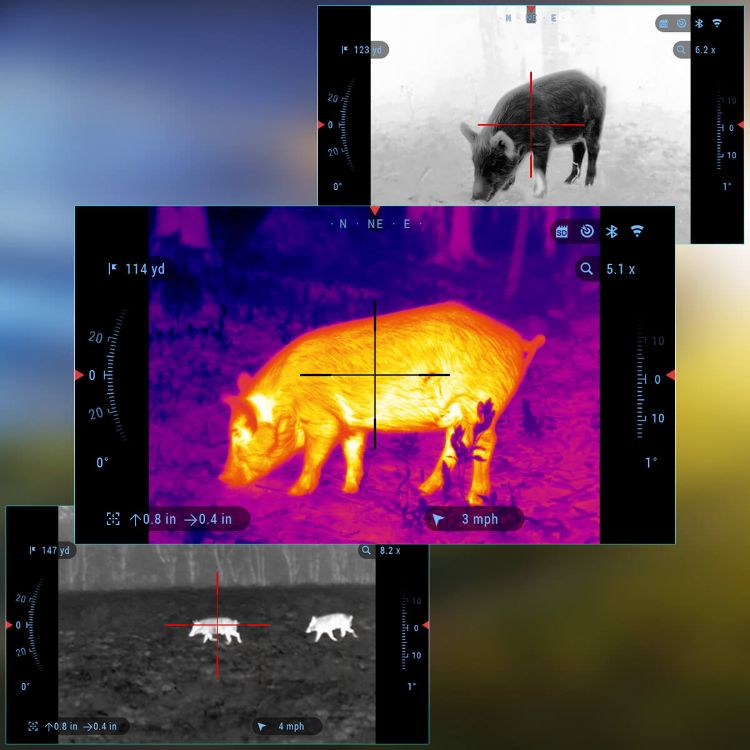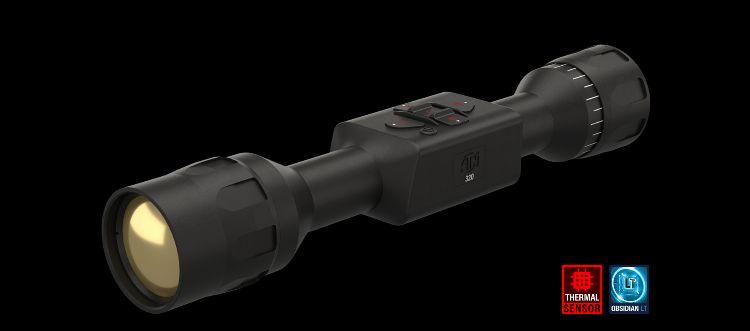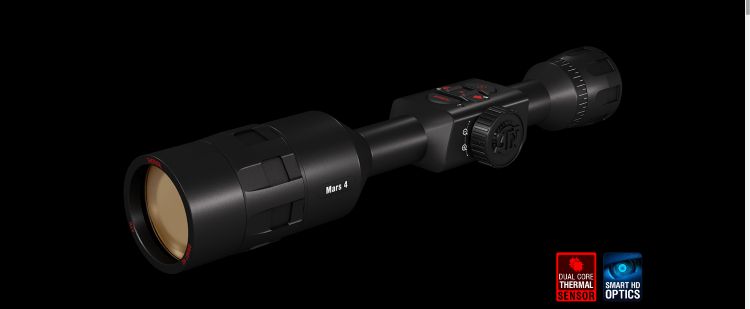As thermal sensor technology decreases in price, more manufacturers are coming to market with their version of a thermal rifle scope. Yet it's dangerous to make a purchase decision based solely on looks or price, with vast differences in capability and quality between scopes. ATN has been manufacturing rifle scopes for over two decades, and for this article, we asked their experts to guide us through thermal technology specifications and the key decisions a first-time buyer should consider before parting with their hard-earned cash.
How does a thermal scope work?
The power and utility of a thermal scope stem from it not needing to rely on light to create a picture. Instead, it uses infrared radiation emitted by objects, with the amount of radiation emitted corresponding to each object's temperature. A thermal sensor within the scope senses the radiated energy and amplifies the result, applying different shades or colors to each temperature. The resulting picture is a heat map, usually showing warmer objects as lighter and cooler objects as darker.
 Which is better, a Thermal or Night Vision scope?
Which is better, a Thermal or Night Vision scope?
Neither choice is better than the other, as both have their uses. Much depends on your particular hunting methods, hunting grounds, and the weather and light conditions you usually encounter. Night vision technology amplifies reflected light to create a picture, so you need some light for night vision scopes to function adequately. The reflected light deteriorates on moonless nights, under overcast skies, or when fog or smoke is present, and the operation of the night vision scope also deteriorates. Night vision technology can also strike limitations when grass or foliage obscures the game.
Neither of these concerns impacts thermal technology. The thermal sensor functions equally well day and night and at all light levels. It also will show the temperature signature of game hiding in grass or foliage due to the higher temperature of the game when compared to the surrounding features. So if you regularly hunt in areas with long grass and extensive foliage or in conditions of heavy overcast or on moonless nights, thermal technology will succeed where night vision will fail.
Specifications to look for when choosing a thermal scope
There are eight key specifications you should consider when comparing thermal scopes.
Magnification
Gone are the days when you could choose only a few scope magnifications. Now we're spoiled for choice. When choosing which magnification to select, everything depends on the distance you'll be shooting and the size and agility of your game.
A scope's magnification affects the field of view through the scope, which measures how much you can see. The higher the magnification, the further you see but the narrower your field of view. Manufacturers quote a field of view in degrees, which lets you work out the width of the area you can see at 100 yards or meters.
The wide field of view offered by lower magnification scopes makes it easier to track moving game. If the field of view is too narrow, you can easily lose sight of the game when it moves, and you'll struggle to locate it again. Higher magnification scopes are ideal for smaller game over longer distances or larger game that is stationary.
If you're a weekend hunter who hunts in heavy cover and rarely engages game at more than 100 meters, a magnification in the 3 - 10x range will adequately meet your needs. However, if you’re hunting at ranges up to or beyond 1,000 meters, you'll need a scope that can magnify to at least 25x to 35x.
Scope and sensor resolution
Magnification ability is irrelevant if your rifle scope's resolution is poor and offers an inadequate sight picture. The thermal sensor and the display are the two components that decide your image clarity.
Four common pixel counts you'll see quoted for thermal sensors are:
- 160 x 120
- 320 x 240
- 384 x 288
- 640 x 480
As thermal sensor resolution influences scope cost, you'll commonly find the 160 x 120 and 320 x 240 sensors in scopes designed for closer range and affordability. Manufacturers use the more expensive 384 x 288 and 640 x 480 sensors in premium and higher magnification rifle scopes.
Notwithstanding sensor resolution, you need a display that adequately conveys the best image to your eye. Don't settle for anything less than a high-definition display at 1280 x 720 pixels; otherwise, you might be paying for a high thermal sensor resolution that the display can't adequately exploit.
Scope detection range
The Johnson criteria is a method devised post-World War II to describe the capabilities of image-intensifying optics. Three measures quoted in thermal rifle scope specifications come from this criterion: called the detection, recognition, and identification ranges.
Detection means that you will see a heat signature at the quoted range. You will be unable to identify the object, but you will know something is out there. Recognition is the range at which you can discern the difference between a person and an animal. Identification is the distance at which you can tell the gender of a person and the articles of clothing they are wearing.
With each measure based on a defined criterion, the detection, recognition, and identification ranges allow a direct comparison between competing thermal rifle scopes. It's worth noting that adverse environmental conditions will reduce the manufacturer-quoted distances for a thermal rifle scope.
Reticle pattern
With modern digital rifle scopes, there is no excuse for not being given a selection of reticle types, as each hunter will have their preference. Premium scopes for long-range hunting or target shooting will offer a Mil-Dot reticle, with some even allowing the shooter to program the variance between the hash marks. Look also for a simple and reliable method of zeroing the scope.
Refresh rate
A digital rifle scope's display constantly refreshes or updates the image shown. Manufacturers often quote the speed at which this refresh occurs in hertz (Hz), a unit of frequency where 1 hertz is equal to one event per second. Refresh rates are less important when everything in the displayed image is static, but once things start moving, you'll instantly notice a slow refresh rate.
Most digital rifle scopes use a refresh rate between 30 and 60 hertz; below 30 hertz, the image can become jerky or choppy, and you'll notice a lag in the on-screen movement. Expect premium scopes to use 60-hertz refresh rates.
Zoom type
When you've located your game, you frequently wish to increase the magnification to take your shot. The ease with which you can adjust the scope magnification when wearing gloves and the smoothness of the zoom are differentiators when choosing between scopes. Quality rifle scopes will have ergonomic and smooth zoom capabilities to ensure you can adjust quickly and easily before getting your shot away.
Battery life
The last thing you need when operating a thermal rifle scope is to run out of battery power at a critical point. Before purchasing a thermal scope, check the battery durations you can expect and whether that will support your type of hunting. Expect most consumer-grade thermal scopes to give you at least 7 to 8 hours of use on a single charge, while high-end products will run to ten or more hours.
Warranty
It’s not a useability issue, but having a lengthy warranty with a reputable company will give you peace of mind. Thermal scopes use advanced technology and are not cheap; therefore, if something goes wrong, you need to be confident you can take the scope back to the manufacturer for rectification. Warranty periods vary between manufacturers and range from 12 months to 3 years. Given the cost of a thermal scope, look for manufacturers who are prepared to back their product for a reasonable time.
The best ATN thermal rifle scopes
The following two thermal rifle scopes from ATN will cover most hunting situations while providing quality, performance, and useability.
 ATN MARS LT 320 5-10X
ATN MARS LT 320 5-10X
The LT range of thermal rifle scopes from ATN offers a lightweight thermal scope with all the features you need but at a price that won't break your budget. The LT 320 5-10x weighs only 650 grams and has a 320 x 240 12µm sensor coupled with a high-definition 1280 x 720, 60 Hz display to ensure the resolution you need for hunting at closer ranges. You can choose between white hot or black hot viewing modes and multiple reticle styles for your display preference.
Battery endurance exceeds ten hours, and you can recharge via a USB port. If you require a longer battery endurance, the LT 320 5-10x has an optional extended power pack lasting more than 22 hours.
Regarding capability, the detection, recognition, and identification ranges of the 5-10x are 1600, 710, and 415 meters, respectively, with the body hardened to resist the recoil of heavy caliber rifles. As with all ATN scopes, the LT 320 5-10x ships with a three-year warranty. As the lightest thermal scope offered by ATN, this is the one you need when size and weight are critical or for smaller platforms like air rifles and crossbows.
 ATN MARS 4 640 4-40X
ATN MARS 4 640 4-40X
The Mars 4 640 4-40x is ATN's premier thermal scope, providing a huge variable magnification. It uses a fourth-generation thermal sensor with a resolution of 640x480, refreshing at a fast 60 Hz and offering a best-in-class thermal sensitivity of less than 25 mK. The high-definition 1280x960 display offers a smooth zoom and ensures you receive the outstanding resolution of the thermal sensor at the eyepiece. Based on those specs alone, the 4-40x is a top-shelf product.
You can choose your image display from black hot, white hot, or color mode, and you have multiple reticle and color options. The 640 4-40x also comes with ATN's smart Mil-Dot reticle, which allows you to program the variance in hash marks depending on your load, which the scope then adjusts dynamically throughout the zoom range. The detection, recognition, and identification ranges of the 4-40x are truly impressive, at 3,300, 1,250, and 800 meters, respectively. In keeping with a scope of this quality, the body is constructed of hardened aluminum alloy and contains impact-resistant electronics to withstand the punishment of high-caliber weapons.
To support the advanced technology used in the Mars 4, ATN powers the scope with their Obsidian IV Dual core processor. You can select the recoil-activated video feature or simultaneously dual-stream high-definition video to an internal SD card and your mobile device. You also gain a ballistic calculator, a smart rangefinder, and a one-shot zero functionality. Despite all this computing power, the Mars 4 640 4-40x has a battery duration exceeding 16 hours. Finally, for peace of mind, you receive a three-year warranty.
Final Thoughts
With so many thermal rifle scopes on the market, making the right purchase choice can be bewildering. To compound matters, the needs of each hunter are unique. Therefore, before you make a purchase decision on a particular thermal scope, our ATN experts suggest you consider the eight specifications listed above and decide which of those features are necessary for your hunting and at what level of specification.
The two thermal scopes suggested by ATN nicely bracket the needs of most hunters; however, on their webpage, ATN offers a selection of eight thermal rifle scopes with varying magnifications and characteristics. If you wish further information before you buy a thermal scope, ATN experts are available to take your call to answer questions and support your selection process.